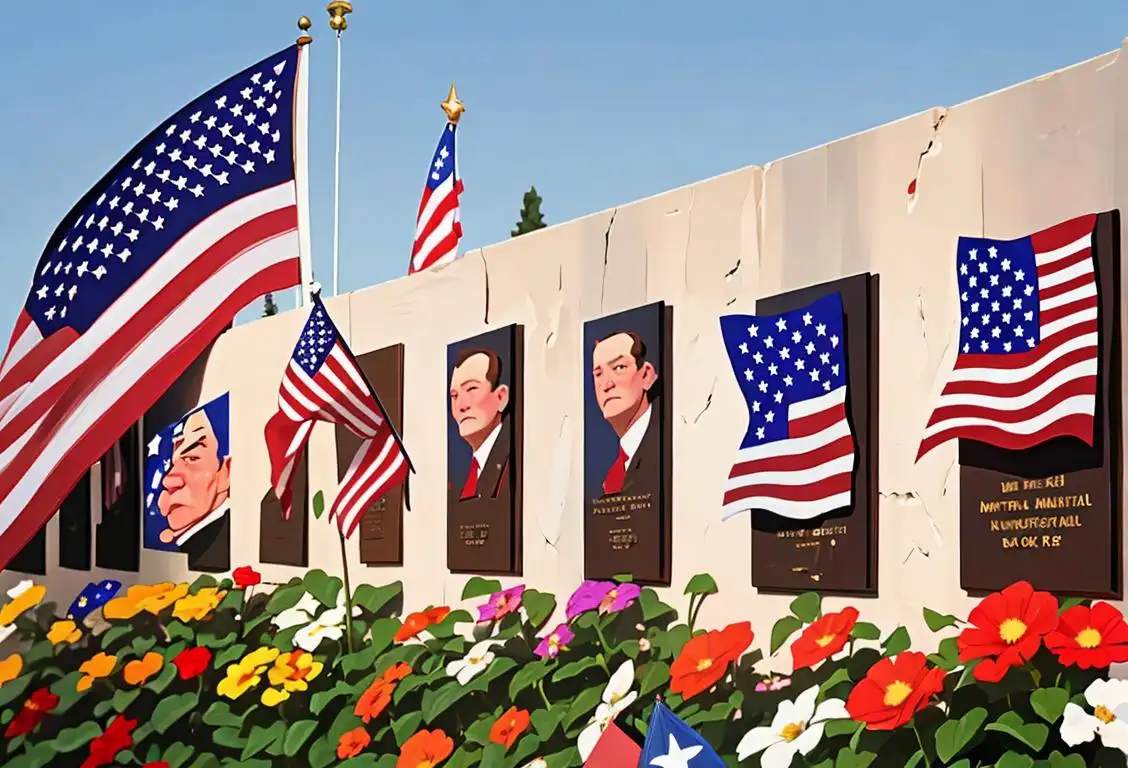National Boy Scout Day

Ah, National Boy Scout Day! It's a day to celebrate all those brave and resourceful young souls who have embraced the adventurous spirit of scouting. Whether they're tying knots, building fires, or helping little old ladies cross the street, these scouts are ready to lend a hand and have some fun along the way.
When is Boy Scout Day?
It's national boy scout day on the 8th February.
The Origins of National Boy Scout Day
Let's dive into the internet history and uncover how this special day came to be. National Boy Scout Day is observed on February 8th every year, and it commemorates the founding of the Boy Scouts of America in 1910. Wait, did someone say 1910? That's over a century ago! Back then, a group of visionary leaders, including the legendary Sir Robert Baden-Powell, decided to introduce a program that would teach young people valuable life skills, encourage community service, and foster outdoor adventures.
Since its humble beginnings, the Boy Scouts of America has grown into a massive movement, bringing together millions of boys and girls from all walks of life. Whether they're pitching tents, identifying constellations, or helping with community projects, these scouts are making a positive impact on the world around them.
Celebrating National Boy Scout Day
So, how can we celebrate this joyous occasion? If you're part of the scouting community, you might organize a special event or gather with fellow scouts to swap stories of your adventures. You could even wear your scout uniform with pride and show off those hard-earned merit badges. And if you're not a scout? Well, you can still join in on the fun by learning some scout skills or supporting your local scouting organization through donations or volunteer work.
Remember, National Boy Scout Day is not just about scouts—it's an opportunity for everyone to appreciate the values of preparedness, teamwork, and service to others. Plus, who can resist those iconic scout cookies? Grab a box (or three) and savor the deliciousness while supporting a great cause!
The Fun Fact You Didn't Know
Did you know that the Boy Scouts of America played a crucial role during World War II? Scouts were actively involved in various war efforts, such as collecting scrap metal, growing victory gardens, and even working as messengers and firefighters. These courageous young men and women proved that scouting was not just about camping and knot-tying—it was about stepping up when your country needed you the most!
History behind the term 'Boy Scout'
1907
Founding of the Boy Scouts
In 1907, British army officer Robert Baden-Powell organized the first experimental camp on Brownsea Island, Dorset, UK. This marked the founding of the Boy Scouts, a youth organization focused on developing character, leadership, and outdoor skills. Baden-Powell's aim was to provide boys with a program that combined fun activities with moral values and self-reliance.
1907
The Beginnings of Scouting
In 1907, British soldier and writer Robert Baden-Powell organized an experimental camp on Brownsea Island in England. This camp brought together 20 boys from different social backgrounds to test Baden-Powell's ideas about training young boys in outdoor skills, self-reliance, and character development. The success of this experiment laid the foundation for the worldwide Scouting movement.
1907
The Birth of the Scout Movement
In 1907, British army officer Robert Baden-Powell organized the first experimental camp on Brownsea Island, off the coast of England. The purpose of this camp was to test his ideas about training young boys in outdoor skills, leadership, and character development. Baden-Powell's vision was to create a program that would mold boys into responsible and self-reliant individuals.
1908
The First Scout Handbook
In 1908, Robert Baden-Powell published his book titled 'Scouting for Boys,' which served as the foundation for the Boy Scout movement. This book outlined the principles and activities that would shape the character of young boys. It contained information on camping, woodcraft, first aid, chivalry, patriotism, and other essential skills. 'Scouting for Boys' became a massive success, spreading the concepts of scouting across the globe.
1908
Publication of Scouting for Boys
In 1908, Baden-Powell published a book titled 'Scouting for Boys,' which outlined the principles and activities of the Boy Scouts. The book was an instant success and spread the ideals of scouting worldwide. It became a fundamental resource for boys interested in joining the movement and played a crucial role in popularizing the term 'Boy Scout'.
1908
The Publication of 'Scouting for Boys'
In 1908, Baden-Powell published the iconic book 'Scouting for Boys.' This guidebook outlined the principles of Scouting, including activities, skills, and ideals that would shape the character of future Scouts. 'Scouting for Boys' quickly gained popularity and was embraced by young boys across various countries, sparking the growth of what would become a global movement.
1910
The Formation of Boy Scouts of America
In 1910, William D. Boyce, a publisher, and adventurer, encountered a young Boy Scout in London who helped him find his way. Impressed by the scout's preparedness and helpfulness, Boyce brought the scouting movement to the United States. On February 8, 1910, he and a group of prominent leaders founded the Boy Scouts of America (BSA). The BSA rapidly grew and adopted Baden-Powell's principles, becoming a cornerstone of youth development in the United States.
1910
Formation of the Boy Scouts of America
In 1910, American businessman W.D. Boyce was visiting London when he encountered an unknown scout who guided him through the foggy streets. Inspired by the helpfulness and resourcefulness of the scout, Boyce decided to bring the movement to the United States. On February 8, 1910, he established the Boy Scouts of America, introducing the term 'Boy Scout' to the American lexicon.
1909
Formation of the Boy Scout Association
Following the overwhelming response to 'Scouting for Boys,' the Boy Scout Association was officially formed in the United Kingdom in 1909. This association aimed to organize and promote the original Scouting program. It brought together various local Scout patrols and established a framework for leadership, training, and advancement within the movement.
1910
Scouting Reaches the United States
In 1910, American publisher William Boyce encountered a helpful young boy in London, who guided him to his destination despite the foggy streets. Inspired by this act of kindness, Boyce learned about Scouting and decided to bring it to the United States. He incorporated the Boy Scouts of America (BSA), which officially started on February 8, 1910. The BSA adapted Baden-Powell's principles to suit American culture and values.
1916
The Official Boy Scout Handbook
In 1916, the Boy Scouts of America published the first official handbook, known as the 'Handbook for Boys.' This comprehensive guide provided scouts with practical information on camping, tracking, knot tying, first aid, and citizenship. The handbook underwent several revisions over the years to adapt to changing times, but it remained a fundamental resource for scouts, imparting valuable skills and character development.
1911
Introduction of the Scout Law
The Scout Law, a set of guidelines for moral conduct, was introduced in 1911. It emphasizes qualities such as trustworthiness, loyalty, and helpfulness. The Scout Law became an integral part of the Boy Scout program, guiding young boys on the path to developing good character and responsible citizenship.
1950
Cultural Impact and Worldwide Boy Scouting
By the 1950s, the Boy Scout movement had gained significant popularity worldwide. Scouting became an integral part of the cultural fabric in many countries, emphasizing the values of loyalty, duty, and community service. Boy Scouts contributed to disaster relief efforts, environmental conservation projects, and various community initiatives, instilling a sense of civic responsibility in young boys.
1912
The First Eagle Scout
The Boy Scouts of America introduced the rank of Eagle Scout in 1912, recognizing the highest level of achievement within the program. Arthur Eldred became the very first Eagle Scout on September 2, 1912, signaling the start of a prestigious tradition. Since then, over two million young men have earned the rank of Eagle Scout, exemplifying the commitment to leadership, service, and character development.
1916
Merit Badges Introduced
In 1916, the Boy Scouts introduced merit badges as a way for scouts to learn specific skills and gain practical knowledge. Merit badges covered a wide range of subjects, including first aid, cooking, camping, and citizenship. Achieving merit badges allowed Boy Scouts to demonstrate proficiency in different areas and encouraged a well-rounded approach to personal growth.
1924
Worldwide Spread of Scouting
By 1924, scouting had spread to many countries around the world. National scouting organizations were established, often using the term 'Boy Scout' to describe the youth members. Scouting became a global movement, promoting camaraderie, outdoor adventure, and community service among millions of boys.
1948
Inclusion of Cub Scouts
In 1948, the Boy Scouts of America introduced the Cub Scouts program for younger boys. This addition expanded the organization's reach and allowed boys from a younger age to participate in the scouting experience. Cub Scouts would later build a strong foundation for boys to transition into Boy Scouts when they reached the appropriate age.
2000
Introduction of Venturing Program
In 2000, the Boy Scouts of America introduced the Venturing program, which focuses on older teenagers and young adults. Venturing offers a more challenging and diverse set of activities, including high adventure expeditions, community service projects, and leadership development opportunities. It allows young men and women to continue their scouting journey beyond the traditional Boy Scout age range.
Did you know?
Did you know that the Boy Scouts of America played a crucial role during World War II?Tagged
awareness funFirst identified
8th February 2016Most mentioned on
8th February 2021Total mentions
202Other days
Nurses Day
Former Prisoner Of War Recognition Day
Press Day
Handloom Day
Heroes Day
Memorial Day
Dance Day
Bestfriends Day
Liberation Day
Love Your Pet Day









